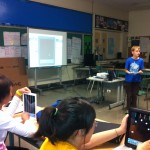“Salt and water combine to form salt water, which sinks below pure water. Heating up salt water causes it to split back into salt water and steam. Steam rises and condenses, eventually forming water droplets. Plants drink water and grow, but die if exposed to salt water. And that’s just three of the nineteen materials available for you to draw.” – World of Sand
What I’ve discovered most about my students in this Gifted program, is that they want challenge. Not just any challenge, but a challenge that doesn’t have just one answer, but a myriad of possibilities. They want a challenge that can be done, and re-done over and over, with different results or possibilities. They want to create the challenge, to ask the questions, and to discover solutions. The epitome of inquiry?
Today, one of the students finally got to implement HIS challenge. Details posted on his blog post – “World of Sand Challenge” (A comment on his post would result in a smile).
 Using the REFLECTION app on the SMARTBOARD along with the iPad app World of Sand, he demonstrated how to combine the elements, tools and chemicals to create reactions. Once the students had a chance to practice, he set specific guidelines: Acid, Liquid Fire and Acid to be set as “automatic” – in that order. The problem? Combine the other elements so that these elements/chemicals do not touch bottom of screen.
Using the REFLECTION app on the SMARTBOARD along with the iPad app World of Sand, he demonstrated how to combine the elements, tools and chemicals to create reactions. Once the students had a chance to practice, he set specific guidelines: Acid, Liquid Fire and Acid to be set as “automatic” – in that order. The problem? Combine the other elements so that these elements/chemicals do not touch bottom of screen.
Here is one student explaining their result. I feel humbled to be part of their learning journey.

